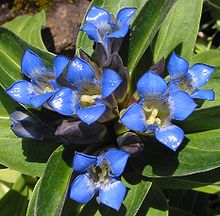Gentianales
| Gentianales | |
|---|---|

| |
| Gentiana cruciata | |
| Scientific classification | |
| Kingdom: | Plantae |
| Clade: | Tracheophytes |
| Clade: | Angiosperms |
| Clade: | Eudicots |
| Clade: | Asterids |
| Clade: | Lamiids |
| Order: | Gentianales Juss. ex Bercht. & J.Presl |
| Families | |
| Synonyms | |
Gentianales is an order of flowering plants, included within the asterid clade of eudicots. It comprises more than 16,000 species in about 1,138 genera in 5 families.[1] More than 80% of the species in this order belong to the family Rubiaceae.
Taxonomy
In the classification system of Dahlgren the Gentiales were in the superorder Gentianiflorae (also called Gentiananae). The following families are included according to the APG III system:[1]
- Family Apocynaceae (424 genera)
- Family Gelsemiaceae (2 genera)
- Family Gentianaceae (87 genera)
- Family Loganiaceae (13 genera)
- Family Rubiaceae (611 genera)
Phylogeny
The following phylogenetic tree is based on molecular phylogenetic studies of DNA sequences.[2]
| Gentianales | |
Etymology
It takes its name from the family Gentianaceae, which in turn is based on the name of the type genus, Gentiana. The genus name is a tribute to Gentius, an Illyrian king.
Uses
Well-known members of Gentianales are coffee, frangipani, Gardenia, gentian, oleander, and periwinkle.
References
- ^ a b Angiosperm Phylogeny Group (2009). "An update of the Angiosperm Phylogeny Group classification for the orders and families of flowering plants: APG III". Botanical Journal of the Linnean Society. 161 (2): 105–121. doi:10.1111/j.1095-8339.2009.00996.x.
- ^ Backlund M, Oxelman B, Bremer B (2000). "Phylogenetic relationships within the Gentianales based on NDHF and RBCL sequences, with particular reference to the Loganiaceae". American Journal of Botany. 87 (7): 1029–1043. doi:10.2307/2657003. JSTOR 2657003. PMID 10898781. S2CID 15433433.

